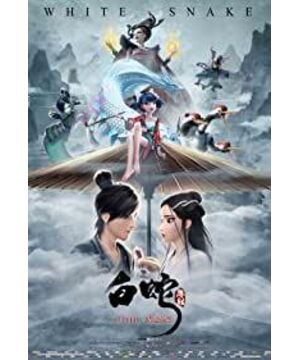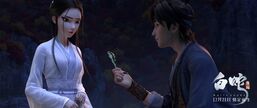Preface (previous life of animation): In this life, new media and new technologies have become an important part of film and media culture in recent years, and they extend or cross the boundaries of traditional narrative films. Although animated films have been part of the history of power since its inception, the development and refinement of digital animation over the past 15 years has sparked a "renaissance" in the field of animated films—from Toy Story (1995) to Super Big Bad (megamind, 2010) – has the ability to create more sophisticated and complex images than ever before (Timothy J Corrigan, How to Write a Film Review)
This film review will analyze the cartoon "The Origin of the White Snake" from the perspective of genre and make a horizontal comparison with "Green Snake" directed by Tsui Hark
From the point of view of type, the genre classification of "The Origin of the White Snake" left on the major websites is love animation fantasy, but in my opinion, the genre classification of "The Origin of the White Snake" is far less rough. First of all, this animation also contains bias. Tomb robbery means Qimen Dunjia-style exploration, which is not only a breakthrough in the genre of "Origin of the White Snake", but also a feature of "Green Snake", which is not available in all the films that tell the story of the White Snake. The five elements, gossip and exercises are described in more detail. Can it be regarded as a combination of love story and fantasy adventure magic (combined with the upsurge of IP changes in adventure tomb raiding in recent years, "The Origin of the White Snake" has stepped on this limelight very well) In the process of every major transformation, the number of hexagrams also has its place. The addition of traditional concepts makes the whole film three-dimensional. As Guoman, it promotes traditional Chinese culture. It is not like "Green Snake". Spells pass by but bravely show this aspect, given that the film is only 99 minutes long, but when faced with the part that needs to be "explained", it does not choose to avoid blurring and conceptualizing it, but in the film's Internally, a system of its own has been established to form a model of self-interpretation. Of course, this is only the first role of magic, hexagrams and exercises in this film. His second role lies in the concept of exercises throughout the whole chapter. There is also a directional meaning in the introduction. At the beginning, because the emperor wanted to live forever, the national master practiced Taiyin Zhengong (the practice requirement of Taiyin Zhengong is to use snakes). At this time, the Taiyin Zhengong method acts as a directional arrow to connect the original. In the film, the Snake Clan and those in power broke apart and completed the first separation of the exercises. The orientation means that there is another time at the end of the film. The female leader of the Snake Clan also killed his apprentices after "defeating" the national master. The purpose of death is also to cultivate one's own practice (ten thousand yuan returns to the sect to communicate with each other) At this moment, the practice is again full of directional meaning, and the master and Axuan Xiaoqing and Xiaobai are separated, and the second separation is completed. Let's see that the director has successfully concretized the abstract concept of the secular division of right and wrong, good people and bad people, into a method of practice (that is, power), and quietly transformed the standard of good and evil that both humans and monsters should have into the owner of power. or the owner of desire
From this, we can see that "The Origin of the White Snake" as a whole animation still reveals a little bit of balance. The whole "Origin of the White Snake" starts from the perspective of ordinary people like A Xuan, which is different from "Blue Snake". The narrative angle is different. The angle that often affects the audience's interpretation of the film is different from that of "Green Snake" from the perspective of Bai Niangzi as the main point of view of Fa Hai as a supplement. In "Green Snake", Xu Xian has completely become a foil for the above two characters and behaviors. The line white lady is more emotional and Fahai is more rational. The two wander around Xu Xian, and the perspective of "The Origin of the White Snake" is placed on the general public. Although the film still retains a lot of love elements, its charm has quietly changed. Compared with "Green Snake", it seems more extensive. In the traditional stories that the audience understands, the white snake is usually a seductive image. It is to achieve the image of his own desires. Xiaobai is completely de-typed in the character image, and Xiaobai is completely portrayed as a little more virtuous and virtuous and a little less seductive. The white snake, a snake demon prototype character, has completed a reversal. In addition, although the whole film is a A flashback method, but the overall presentation is still a linear narrative method, but the distance between Xiaobai and Axuan hidden when the surface story process is about to complete a closed ending is indeed a gradually opening ending. From the very beginning when Axuan was a human and Xiaobai mistakenly thought he was a human being to the following Xiaobai was a demon Axuan was a human to Axuan Xiaobai was a demon at the same time when Xiaobai lost his memory and finally Xiaobai lost his practice (completed a certain meaning The humanoid on the top) Axuan only kept the soul (entering the second world to complete the ghost-like transformation). For example, in "Green Snake", Fa Hai chose to let the two sisters of the white snake and Qing snake go to Xu Xian's Buddha beads. It avoids the white snake Fahai and his image of the back of the Jinshan Temple and becomes the image of the "impaired person". Both Xu Xian and the white snake are fighting for their own desires. They are fighting against Fahai just to satisfy their own love, which is completely private. In terms of story contradictions, "Green Snake" is regarded as a classic, but the contradictions are always single, in order to enlarge the contradiction with Fahai. The gap and contradiction between the human and the demon are infinitely narrowed. The white snake sisters who save water from the water are always "monk" and "demon", but in "The Origin of the White Snake", the white snake and Axuan have become the representatives of rebellion against the power. Diverse (only on snakes)
Another very meaningful point in "The Origin of White Snake" is the establishment of the status of female characters. At the beginning of the linear narrative, the system of women begins to establish the contrast between Xiaobai and the old woman in Snake Village, as well as the appearance of the snake master and the femininity of the national master and apprentice. The male image, etc. is not only to indicate that the above female characters have a boosting effect on the intensification of the conflict in the development of the plot, but more importantly, the female feelings conveyed in the whole film are different from "Green Snake" and "The Origin of White Snake". There is a "Fahai" type character without the oppression brought by the so-called classical patriarchy and the enforced moral and ethical concepts. The national teacher is a "fahai-like" character, but the Taiyin real power of cultivation has also given the entire film to countless Men like Duoduo's national teacher have deeper femininity, which means that from a philosophical point of view, the whole film "The Origin of the White Snake" brings more freedom of thoughts and feelings. There is no right or wrong. There is a hint of dialectics in the whole film. The idea of looking at the problem is in line with the ancient Chinese women and the "soft" image that Xiaobai gave the audience in the film. It also benefits from the penetration of Taoism throughout the film. There is no fixed "legal code". The use of the psychological montage of the overlapping of water and fog scenes in the combination of Xiaobai gives the rationality for all independent elements to be explained in the big environment of the film. There are no auxiliary elements, but each element is in a state of complementing each other. The elements all have their own meanings. In the final battle scene, Axuan held Xiaobai and faced the two flying stones. He chose to avoid this spiritual core of not fighting but fighting, and adding beads to the whole story. The element of the hairpin, the bead hairpin, contains fusion and absorption. In the "Blue Snake" Fahai, the monks in the Jinshan Temple rely on the cassocks, and the monks in the Jinshan Temple rely on the wooden fish. The inclusion of pearl hairpins, an accessory that represents women's meaning, makes the emotional fluidity of the whole film more intense on the female side.
The last "White Snake Origin" has some problems, but he challenges all the existing white snake stories and completes a breakthrough in this type of commercial film. The film restores the history to the greatest extent and shows the entire Chinese culture. It is different from other animations that have cooperated with the West to show Chinese stories in the past two years (such as "Kubo and the Erxian Qin"). This "The Origin of the White Snake" is very close to the Chinese style. Combining the popular commercial elements from the conflict of plot design to the moralization (the facial design of the characters with three courts and five eyes conforms to the current aesthetic trend), etc., they are all seeking breakthroughs! In terms of overall philosophical thinking
All in all, "The Origin of White Snake" has created new elements of this type of story. The addition of new elements has innovated the genre and expanded the attitude towards traditional story adaptation. Although the character description is a bit blunt in the second half, it dares to challenge the story of multi-role, multi-scene and large-scale transfer. It is worth repeating. add one star
View more about White Snake reviews











